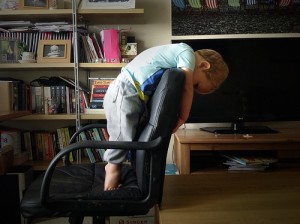The following blog post is contributed by Dr. Anthony Rao a nationally known expert in child psychology, and author of The Way of Boys. Dr. Rao will be a speaker at the INSPIRE 2014 Conference in October 2014.
Image may be NSFW.
Clik here to view.
Getting noticed or standing out is usually a good thing, but not for American boys in school. Their diagnoses for ADHD continue to be too high. What drives this? In my practice, it seems to be coming from teachers. They don’t realize it, but over the last few years they have been telling parents there are more ADHD symptoms in their classrooms, mainly among younger boys. One study found that teachers report ADHD symptoms in an unbelievable 23% of their students.
What’s behind this? As teach-to-the-test and Common Core push schools to make kids sit longer and learn in less interesting ways, misdiagnoses will continue to grow. The ADHD-is-everywhere problem won’t change until there are reasonable breaks for young students to move about while learning, permission to stand at desks and stretch, and more time outdoors for healthy physical activity.
Parents need to act. There are things you can do—at school and at home.
First, band together with like-minded teachers and parents and hold meetings at school. Approach the school board. Start with one voluntary classroom. Do it for a few terms and track the positive changes. Use breaks between lessons, more hands-on learning, time outdoors, integrate natural environments and fun-competition into the curriculum. Currently, all learning tends to be flat (book-screen-paper). Brand your trial program something fun and positive, “Low Stress Learning” or “Healthy Learning.” Remind all parents and the school that there’s a growing body of evidence that these techniques improve learning, lower aggression and distraction, and motivate kids to want to learn. It saves money too—less time disciplining, providing special resources that may not be needed, and decreasing IEPs. It may even lower rates of bullying. Everyone can get behind that!
Second, parents need to make changes at home if we’re going to get a hold on over-diagnosing ADHD. All too often, kids aren’t being prepped correctly for the realities of school. They go from being special, with lots of adult attention, to one of many in a quiet, contained setting. There is much less freedom to talk and move at school when they feel the urge. Basic behavior expectations at home need to be synched more in line with school. If not, there’s often trouble. And this impacts younger boys the most. They get noticed. They stand out. They don’t fly below the teacher’s ADHD radar.
Practice these anti-ADHD techniques. They will protect your child against an accidental diagnosis.
1. Hold off on getting adult/peer attention.Image may be NSFW.
Clik here to view.
Is he used to getting heard, getting his way, and getting undivided attention at home? This won’t happen at school. He has to learn to wait and be one of many. Start a simple program. Delay your responses when he asks for something. Count in your head for 2-3 seconds before you answer, then look up and respond. Tell him you are practicing/teaching him to learn how to wait. This is the basis of patience. If he can wait quietly, give him social praise for the effort. Use a simple point system if that works better. The goal is to wean him off from frequent, immediate attention. You are helping him wait longer and longer, holding back his urges/wants/needs. This won’t work unless you practice this 100% of the time!
2. Tell him he has to attend fully to the directions and requests of adults.
Kids at home do not have to look up and listen every time you talk to them. In a perfect world, they should, but they don’t. I see this all the time in my office. Parents repeat themselves and their kids treat them like they are invisible. At school, your child is likely missing a lot of what the teacher is asking or telling the class unless he shifts his attention more fully. The fix is to practice (at home) what he needs when we walks into the classroom everyday. Four steps.
Every time you ask/tell him something, make sure:
a. He gives you his eyes… he looks up when he hears his name. It should become like a reflex – happens every time – and he continues to look at you while you talk. If he doesn’t, assume he’s only getting 50-75% of what you’re saying.
b. Deliver your request in as few words as possible. Nothing turns boys off more than long conversations/lectures. Use a firm clear voice.
c. Make him repeat it back to you (in his own words). Now those words belong to him and are in his head too.
d. Seal the deal by nodding together, a fist bump – and if you can – attach a consequence.
Now you have a true social contract. Over practice these four steps. If you don’t, he won’t get the practice he needs and it wont carry over to school.
3. Eliminate silly noises.
At home, designate certain times of day when he must suppress this urge (e.g., when at table eating, in front of TV, or when noises bother others). For non-compliance, use a brief time-away in his room and try again. The goal is that he becomes more aware that these sounds are a choice and he has control over them. They are o.k. on the playground or with friends, but not in the classroom. You have to be tough and consistent on this—or gains won’t translate to school. Kids who are too free with silly sounds, blurt out things, and interrupt more, are going to get tagged as ADHD.
4. Improve his boundaries, help him be aware of others’ personal space.
Image may be NSFW.
Clik here to view. This is another common complaint about boys who are physically active and hands-on. They tend to invade personal space more than girls. They need more boundaries set up. This is tricky to do at home where you are more playful and relaxed about boundaries. Unfortunately, if your son is touching peers or getting in their faces while at school, you have to train him on a new set of social rules. When he’s coming forcefully and unpredictably at you, throws himself on you (even to hug), you need to push him back and make him ask permission. You’re not trying to be mean, you’re trying to make him more successful outside the house in how he uses his hands and body. Try a “no touching rule” for a few solid weeks or months, where he always has to ask first. Model this for him. Greater self-control of body will help your son not be seen as ADHD.
This is another common complaint about boys who are physically active and hands-on. They tend to invade personal space more than girls. They need more boundaries set up. This is tricky to do at home where you are more playful and relaxed about boundaries. Unfortunately, if your son is touching peers or getting in their faces while at school, you have to train him on a new set of social rules. When he’s coming forcefully and unpredictably at you, throws himself on you (even to hug), you need to push him back and make him ask permission. You’re not trying to be mean, you’re trying to make him more successful outside the house in how he uses his hands and body. Try a “no touching rule” for a few solid weeks or months, where he always has to ask first. Model this for him. Greater self-control of body will help your son not be seen as ADHD.
Images Courtesy of Flickr Creative Commons
Feature Image
Blog Image 1
Blog Image 2
The post Flying Below the Teachers’ ADHD Radar Screen appeared first on National Institute for Student-Centered Education.
